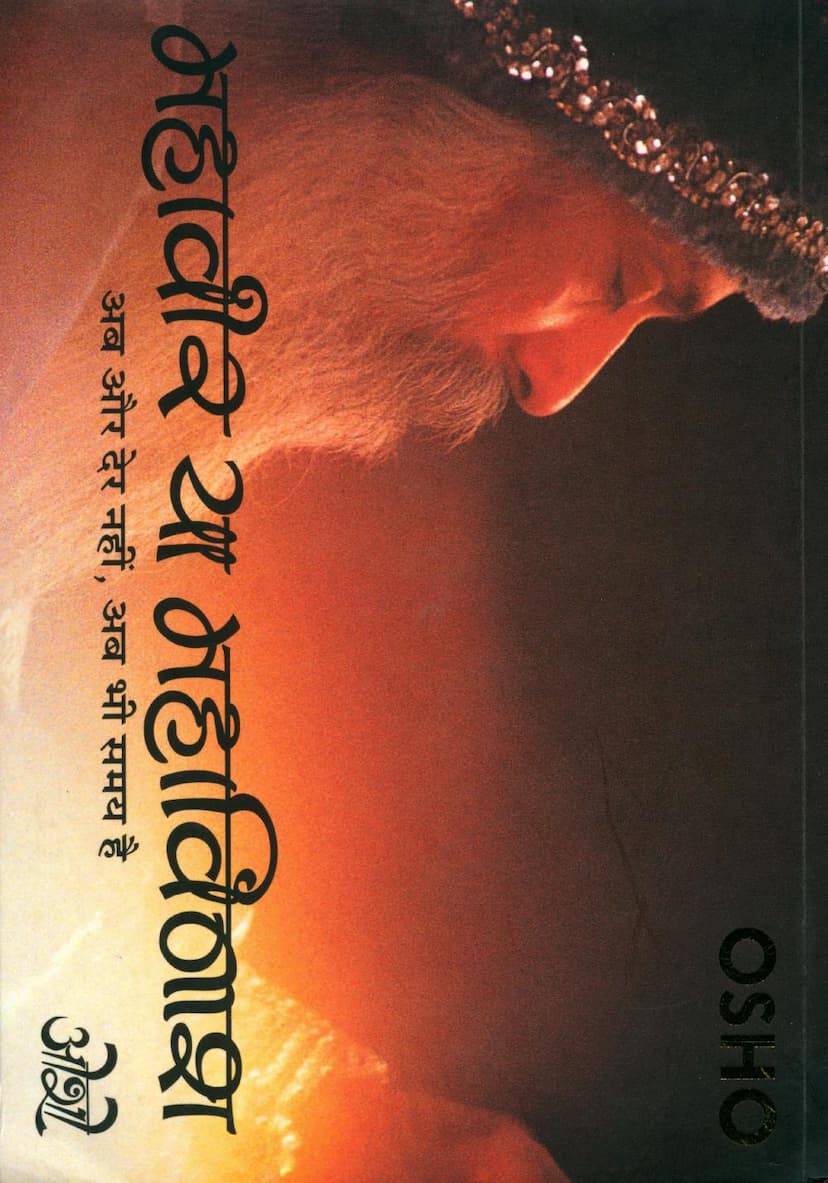Mahavir Ya Mahavinash
Added to library: September 2, 2025

Summary
Here is a comprehensive summary of the Jain text "Mahavir Ya Mahavinash" by Osho:
Book Title: Mahavir Ya Mahavinash (Mahavir or Mahavinash) Author: Osho (Rajnish) Publisher: Rajnish Foundation / OSHO Media International
Core Message:
The central theme of Osho's discourse on Mahavir is that Mahavir's true message is not about worshipping him, but about realizing the inherent divinity within oneself. The book argues that Mahavir's teachings are a call to self-discovery and the awakening of one's own inner potential, which he embodied and proclaimed. The title "Mahavir Ya Mahavinash" (Mahavir or Mahavinash) suggests that humanity is at a critical juncture: either to follow Mahavir's path of inner transformation and liberation (Mahavir) or face annihilation due to destructive tendencies (Mahavinash).
Key Themes and Osho's Interpretation:
-
The Inner Potential (The Seed of Mahavir within Everyone): Osho emphasizes that the capacity to become like Mahavir is present in every human being. Mahavir is not an anomaly or a divine being separate from humanity. Instead, he is the ultimate flowering of human potential, a state that is achievable by all. The "seed" of Mahavir lies dormant within each person, waiting to be awakened.
-
Self-Reliance and Inner Authority: A pivotal aspect of Osho's message is the liberation from reliance on external saviors, rituals, or dogma. Mahavir's core message, as interpreted by Osho, is to stand on one's own feet, to trust one's own inner capacity and courage. He challenged blind faith and external authority, urging individuals to explore their own inner being to find truth and liberation. Osho highlights that Mahavir's elevation of human dignity by stripping away the need for external refuge and declaring "self-reliance" is a revolutionary act.
-
Religion as Experience, Not Doctrine: Osho distinguishes true religion from mere adherence to principles or philosophies. Religion, according to him, is not about memorizing doctrines but about a fundamental transformation of life. It's not an external garment but an intrinsic part of one's being, like breath or heartbeat. Knowing about Mahavir's principles is less valuable than understanding and embodying his way of living, his "life-conduct" (jeevan-charya).
-
The Quest for Anand (Bliss/Joy) over Satya (Truth): While Mahavir is often seen as a seeker of truth, Osho posits that Mahavir's ultimate quest was for Anand (bliss or joy). Truth, in Osho's view, is merely a means to achieve this ultimate bliss. This joy is not found in external pursuits or intellectual understanding but in a state of inner stillness and realization.
-
The Inner Revolution and the Death of the Ego: Osho stresses that becoming like Mahavir involves an inner revolution, the death of the " वर्धमान" (Vardhaman – Mahavir's pre-enlightenment name, symbolizing the ego or the ordinary self) to give birth to "महावीर" (Mahavir – the liberated one). This transformation occurs when the ego ("मैं-भाव" or "अहंता") is dissolved. The ego, Osho states, is the root of all violence.
-
Ahimsa as a State of Being, Not Just Action: Osho clarifies that Mahavir's concept of Ahimsa (non-violence) is not merely about refraining from physical harm. True Ahimsa is an inner state of being, a non-violent consciousness. It arises from the dissolution of the ego ("मैं-भाव"). When the ego is absent, causing harm to others becomes impossible. His interpretation of Ahimsa is deeply rooted in Atma-gyan (self-knowledge).
-
The Illusion of External Wealth and the Power of Inner Wealth: The book critiques the human tendency to chase external possessions, power, and status, which are seen as fleeting and ultimately unable to provide true satisfaction. Osho emphasizes that true wealth lies within, in self-realization. He uses the metaphor of a seed containing the potential of a tree to illustrate this inner potential.
-
The Urgency of Awakening: Osho conveys a sense of urgency, stating that humanity is at a precipice. With the threat of nuclear annihilation (mentioned in the context of hydrogen bombs), the time for mere intellectual understanding or ritualistic practices is over. Humanity must awaken to its inner potential or face destruction.
-
Criticism of Blind Devotion and Ritualism: Osho criticizes the common practice of idolizing and ritualistically worshipping spiritual figures like Mahavir without understanding or embodying their core teachings. He argues that such external worship can become a substitute for genuine inner work, leading to self-deception and a failure to achieve true transformation. He criticizes the tendency to create rigid dogmas and sects around enlightened beings, thus limiting their universal message.
-
The Source of Violence: Osho identifies the root of all violence as the ego ("मैं-भाव"). This ego, the sense of a separate self, drives conflict and suffering. True non-violence (Ahimsa) emerges when this ego is transcended.
-
Living from the Core: The ultimate goal, according to Osho's interpretation of Mahavir, is to live from one's true core, one's authentic self, which is beyond the fluctuations of the mind and the limitations of the physical body. This state of being is characterized by peace, bliss, and unconditional love.
Structure of the Book:
The book is structured as a series of talks (pravachans) given by Osho, each focusing on different facets of Mahavir's life and philosophy. The chapter titles (e.g., "Proclaimer of Human Dignity," "The Rudder of Insight," "The Practice of Self-Realization") indicate the progression of themes, moving from Mahavir's external life and message to the internal journey of self-discovery.
Overall Tone:
The tone is direct, challenging, and revolutionary. Osho doesn't shy away from critiquing societal and religious conventions that he believes obscure the true essence of spiritual teachings. He aims to jolt the reader out of complacency and inspire them to embark on their own path of inner exploration.
In essence, "Mahavir Ya Mahavinash" is Osho's call to humanity to embrace the transformative potential of Mahavir's teachings, not as a dogma to be followed blindly, but as a living inspiration to realize the divine within oneself, thereby averting self-destruction and ushering in a new era of consciousness.